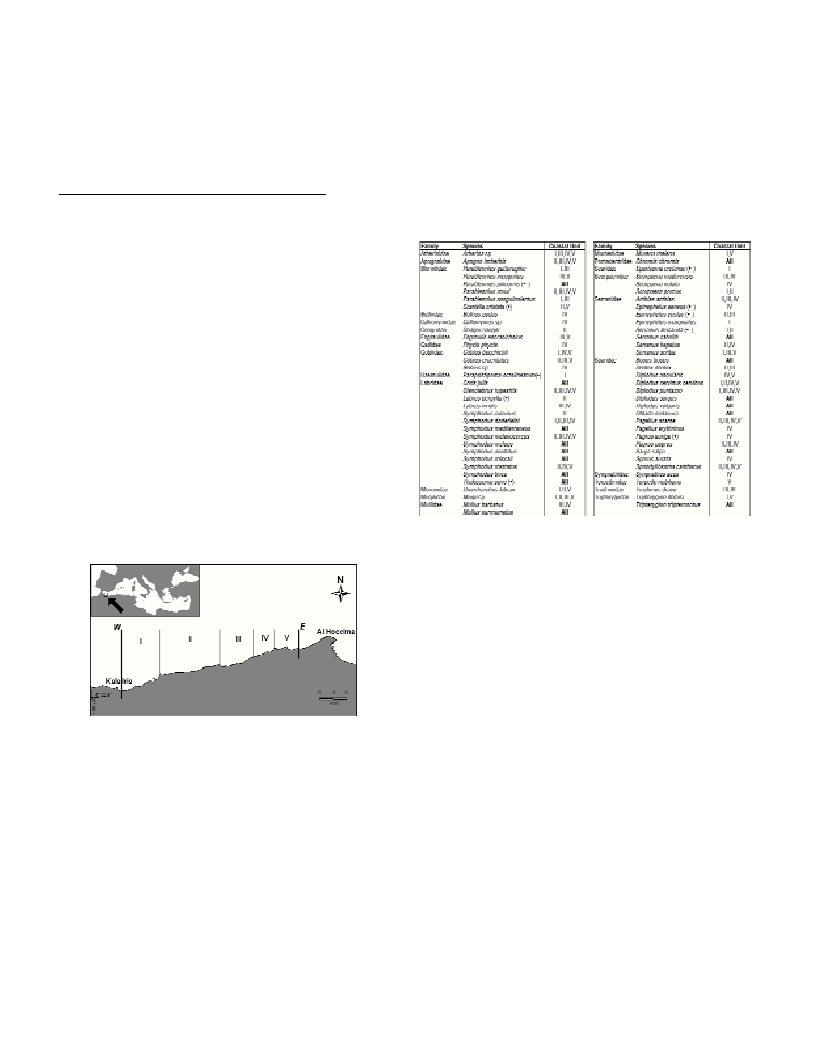FISH ASSEMBLAGES OF THE MOROCCAN COASTAL AREA OF AL HOCEIMA (MEDITERRANEAN SEA)
Molinari A., Salvati E., Tunesi L.*
ICRAM, Rome, Italy - a.molinari@icram.org
Abstract
The fish assemblage of the marine coastal area of the Al Hoceima National Park has been studied in the framework of a research program
for the elaboration of the zoning proposal of the marine park. Collected data show the presence of rich and well diversified assemblages,
characterised by a general dominance of small and medium sized specimens.
Keywords: Visual census, Marine Parks, Alboran Sea
Rapp. Comm. int. Mer Médit., 37,2004
539
Introduction
In the framework of the MedMPA project (regional project for the
development of Marine and coastal Protected Areas in the Mediter-
ranean region), financially supported by the European commission
and coordinated by the Regional Activity Centre for Specially
Protected Areas (RAC/SPA-Tunis), ICRAM has been charged with
the scientific coordination of the study of the Al Hoceima National
Park in Morocco.
Considering the relevance of fish as one of the most important com-
ponents through which the effects of protection become evident in
marine parks [1-3], and the importance of conceiving management
measures for fishery and scuba diving activities [4], two surveys were
carried out to characterise the coastal fish assemblages in the coastal
area applying visual census techniques.
Material and Methods
The coastline of the Moroccan National Park of Al Hoceima inter-
ests about 47 km of Mediterranean coast, characterised by rocky
impervious cliffs. The sampling activity was organised subdividing
the coastal area into 5 sub-homogeneous coastal units (CU) (Fig. 1),
identified on the basis of the main geomorphological features.
Scuba diving paths of 15 minutes were carried out in summer 2002
and 2003 along transects based on four sampling depth ranges (0-3;
4-7; 12-16; 24-30m), in order to acquire semi quantitative data on
abundance and size class composition [5]. At least 3 transects were
planned perCU. The main sea bottom typologies for each path were
registered. A Chi-square test was applied to compare the size class
composition recorded in the five considered CUs.
Results
The low slope encountered on certain transects sometimes did not
allow to reach the 12-16 and the 24-30 m depth ranges. On the whole,
52 paths allowed to identify 69 species (10 Eastern Atlantic and South
Mediterranean). Sparids, Labrids and Serranids were the most
represented families (15, 14 and 8 species respectively).
Only 17 species occurred in all five CUs while another 17 were
each censed only in one CU. This may be due specific characteristics
like crypticity (C.conger, P.phycis, S.notata, S.acus), and rarity
(L.bergylta, S.cretense, E.aeneus, E.marginatus, P.auriga, S.aurata,
T.nobiliana) or because they are associated to soft bottoms (B.podas,
Callionymus sp., Gobius sp., S.cinereus, P.erythrinus). The higher
number of species were recorded in the costal unit IV (48). Highest
species richness were recorded at 0-3 m and 4-7 m (47 species).
Excluding CU I, which is dominated by small specimens (65.8%),
and significantly different from the others (chi-square test, p<0.001),
the fish assemblage of the marine park was characterised by a gener-
al co-dominance of medium sized (from 43.9% to 56.0%) and small
specimens (from 33.7% to 43.3%). The large size class is generally
less represented (from 8.9% to 15.0%). Taking into account only the
first depth range, the I, III and IV CUs were characterised by a high
percentage of small specimens (higher than 60%). The higher percent-
ages of large specimens were recorded in the deeper range (24-30 m)
in the II and III CUs (23.6% and 24.3% respectively).
Discussion and Conclusion
The fish assemblage of the Al Hoceima National Park is rich in
species and characterised by the relevant presence of Eastern Atlantic
and South Mediterranean elements, which testifies the role of the prox-
imate Gibraltar strait. These peculiarities stress the importance of this
national park in protecting a very unique Mediterranean fish assembla-
ge in the framework of a network of Mediterranean marine protected
areas.
The scarce occurrence of large specimens highlights a relevant
fishing pressure, thus emphasizing the importance of implementing
new specific protection measures.
Acknowledgments. Prof.S. Benhissoune of the Faculty of
Sciences- University of Agadir, Morocco, management of the
Ministère des Eauxs et Forêtsand of National Park of Al Hoceima,
and the personnel of the I.T.P.M.
References
1-Villa F., Tunesi L., Agardy T., 2002. Optimal zoning of marine protected
areas through spatial multiple criteria analysis: the case of the Asinara
Island National Marine Reserve of Italy. Conservation Biology, 16(2): 1-12.
2-Tunesi L., Rais C., Benhissoune S., Agnesi S., Bazairi H., Benhamza A.,
Di Nora T., Franzosini C., Limam A., Manca Zeichen M., Mo G., Molinari
A., Nachite D., Piccione M.E., Sadki I., Salvati E., in press. Zoning of the
marine component of the national park of Al Hoceima (Mediterranean,
Morocco): a case study. Biol. Mar. Medit., 11.
3-Halpern B.S., 2003. The impact of marine reserve: do reserve work and
does reserve size matter? Ecological Applications, 13 (1) Supplement:
S117-S137.
4-Agnesi S., Di Nora T. and Tunesi L.,2001. The study of diving tourism
to support the adaptative management in an Italian marine protected area
(Ustica island). Rapp. Comm. Int. Mer. Médit., 36: 347.
5-Harmelin-Vivien M.L., Harmelin J.G., Chauvet C., Duval C., Galzin R.,
Lejeune P., Barnabe G., Blanc F. and Chevalier R., 1985. The underwater
observation of fish communities and fish populations: Methods and
problems. Rev. Ecol. Terre Vie, 40: 467-540.
Fig. 1. Study area: the eastward (E) and westward (W) borders of the Al
Hoceima National Park are shown. The 5 identified coastal units (I-V) are
highlighted.
Table 1. Species recorded in the five coastal units identified along the
study area. (
•
)) Eastern Atlantic and South Mediterranean species.

